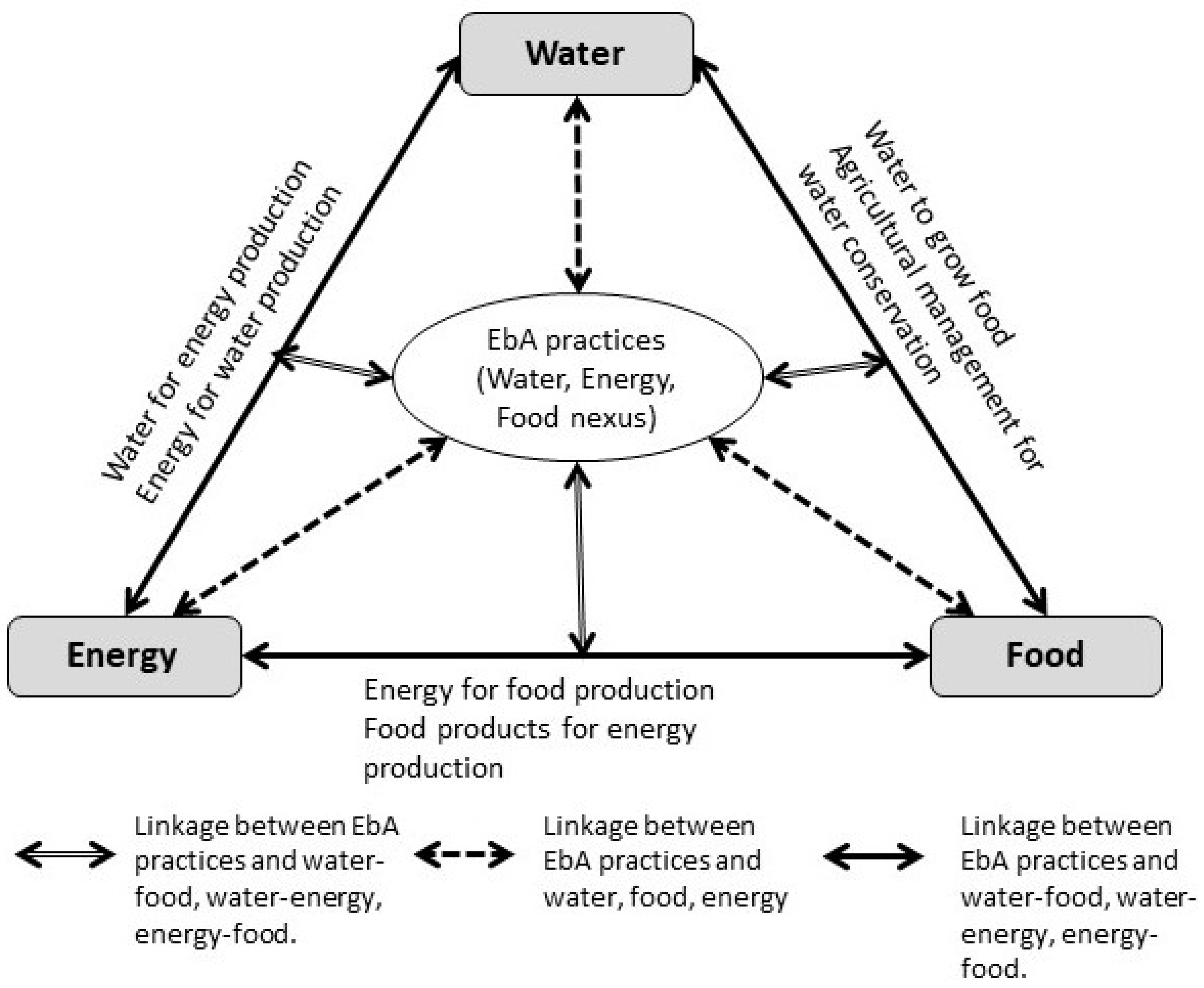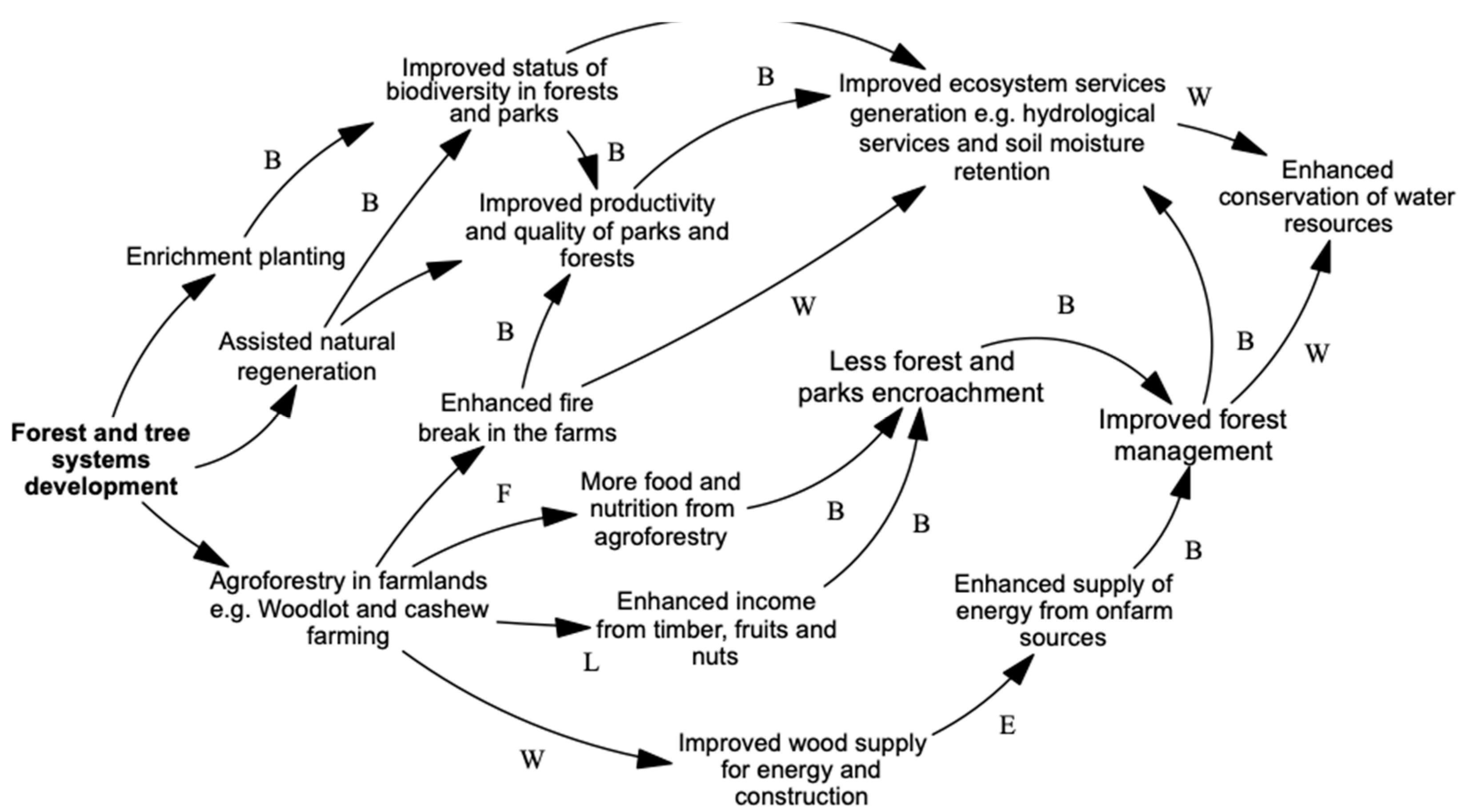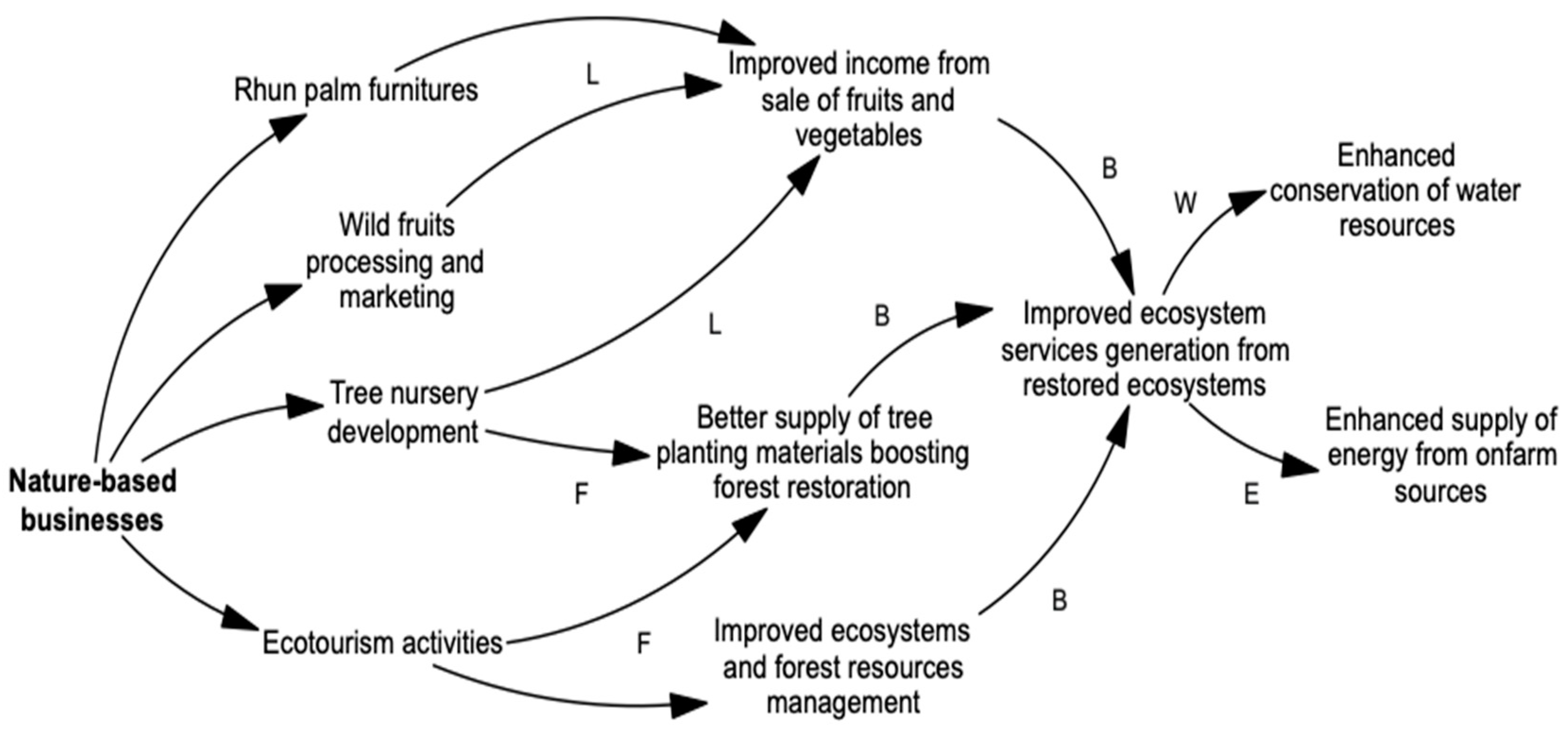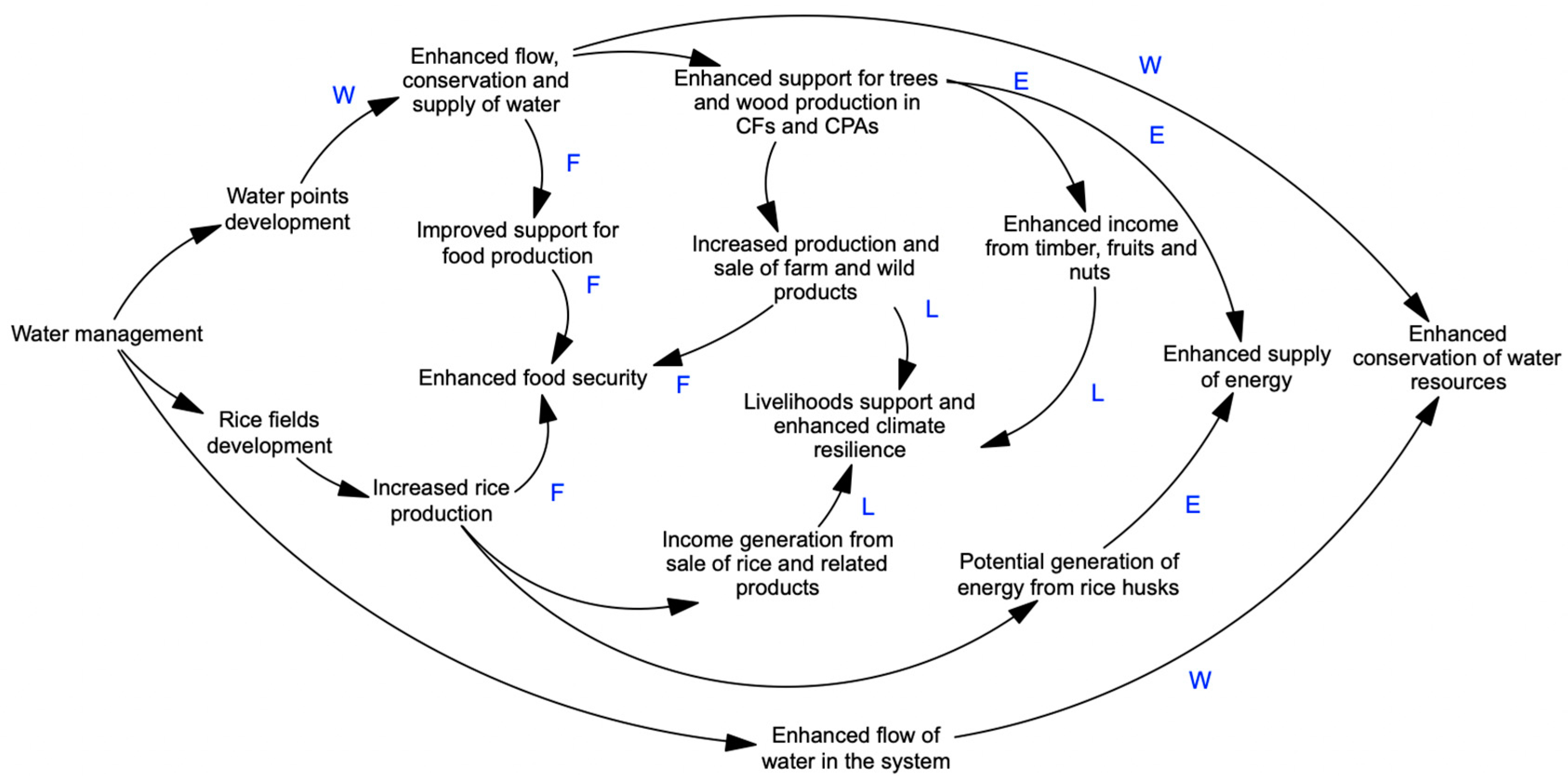Ecosystem-Based Adaptation Practices as a Nature-Based Solution to Promote Water-Energy-Food Nexus Balance
Abstract
1. Introduction
1.1. Study Background
1.2. Scenario Description
1.3. Water-Energy-Food Nexus in Land-Based Activities
2. Methodology
2.1. Proposed Theoretical Framework
2.2. Case Study: The Gambia
2.3. Research Design
3. Results and Discussions
3.1. Preferred EbA Practices in the Community Forests
3.1.1. EbA Practices Under the Forest, Tree, and Wood Development System Cluster
3.1.2. EbA Practices under the Climate-Smart Farming System Cluster
3.1.3. EbA Practices under the Nature-Based Businesses Cluster
3.1.4. EbA Practices within the Water Resources Management Cluster
3.2. Pathways towards WEF Nexus Development through Different EbA Practices
3.3. EbA Practice Contribution to Livelihood Development through the Sustainable Livelihood Framework Lens
3.4. Enablers and Barriers towards Strengthening the WEF Nexus through Different EbA Practices
4. Conclusions and Insights for Practitioners
Author Contributions
Funding
Institutional Review Board Statement
Informed Consent Statement
Acknowledgments
Conflicts of Interest
References
- Pasquini, L.; Cowing, R.M. Opportunities and challenges for mainstreaming ecosystem-based adaptation in local government: Evidence from the Western Cape, South Africa. Environ. Dev. Sustain. 2015, 17, 1121–1140. [Google Scholar] [CrossRef]
- Nguyen, T.T.; Pittock, J.; Nguyen, B.H. Integration of ecosystem-based adaptation to climate change policies in Vietnam. Clim. Chang. 2017, 142, 97–111. [Google Scholar] [CrossRef]
- Chong, J. Ecosystem-based approaches to climate change adaptation: Progress and challenges. Int. Environ. Agreem. Politics Law Econ. 2014, 14, 391–405. [Google Scholar] [CrossRef]
- Duguma, L.; Dibo, D.; Muthee, K.; Minang, P.; Bah, A.; Nzyoka, J.; Malanding, J. Ecosystem-based Adaptation Through the Lens of Community Preferences. ICRAF Tech. Brief 2020, 3. [Google Scholar] [CrossRef]
- Muthee, K.; Mbow, C.; Macharia, G.; Leal Filho, W. Ecosystem-Based Adaptation (EbA) as an Adaptation Strategy in Burkina Faso and Mali. In Climate Change Adaptation in Africa, Climate Change Management; Leal Filho, W., Belay, S., Kalangu, J., Menas, W., Munishi, P., Musiyiwa, K., Eds.; Springer: Cham, Switzerland, 2017. [Google Scholar] [CrossRef]
- Milman, A.; Jagannathan, K. Conceptualization and implementation of ecosystem-based adaptation. Clim. Chang. 2017, 142, 113–127. [Google Scholar] [CrossRef]
- Hoff, H. Understanding the Nexus, Background Paper for the Bonn2011 Conference: The Water, Energy and Food Security Nexus, Stockholm; Stockholm Environment Institute: Stockholm, Sweden, 2011. [Google Scholar]
- Reinhard, S.; Verhagen, J.; Wolters, W.; Ruben, R. Water-Food-Energy Nexus; A Quick Scan; Wageningen Economic Research: Wageningen, The Netherlands, 2017. [Google Scholar]
- Rasul, G.; Sharma, B. The nexus approach to water-energy-food security: An option for adaptation to climate change. Clim. Policy 2016, 16, 682–702. [Google Scholar] [CrossRef]
- Phoju, M.; Dinesh, C.; Tej, M.; Shrestha, T.; Paudyal, M.; Bajracharya, M. Ecosystem Based Adaptation (EbA) & Engineering Options (EOs) as a Solution for Climate Change induced Flood Hazard in Ajgada Village of Udayapur District, Nepal. Int. J. Environ. Sci. Technol. 2019, 5, 10–15. [Google Scholar] [CrossRef]
- Zaman, K.; Shamsuddin, S.; Ahmad, M. Energy-water-food nexus under financial constraint environment: Good, the bad, and the ugly sustainability reforms in sub-Saharan African countries. Environ. Sci. Pollut. Res. Int. 2017, 24, 13358–13372. [Google Scholar] [CrossRef]
- Grigg, N.S. Water–Health nexus: Modeling the pathways and barriers to water-related diseases. Water Resour. Manag. 2019, 33, 319–335. [Google Scholar] [CrossRef]
- Thomas-Hope, E.M. Climate Change and Food Security: Africa and the Caribbean; Routledge: New York, NY, USA, 2017. [Google Scholar]
- Krantz, L. The Sustainable Livelihood Approach to Poverty Reduction: An Analysis; SIDA: Stockholm, Sweden, 2011. Available online: https://www.sida.se/contentassets/bd474c210163447c9a7963d77c64148a/the-sustainable-livelihood-approach-to-poverty-reduction_2656.pdf (accessed on 11 June 2020).
- Serrat, O. The Sustainable Livelihoods Approach. In Knowledge Solutions: Tools, Methods, and Approaches to Drive Organizational Performance; Serrat, O., Ed.; Springer: Singapore, 2017; pp. 21–26. [Google Scholar] [CrossRef]
- Muthee, K.; Mbow, C.; Macharia, G.; Leal Filho, W. Ecosystem services in adaptation projects in West Africa. Int. J. Clim. Chang. Strateg. Manag. 2018, 10, 533–550. [Google Scholar] [CrossRef]
- Karnib, A. Bridging Science and Policy in Water-Energy-Food Nexus: Using the Q-Nexus Model for Informing Policy Making. Water Resour. Manag. J. 2018, 32, 4895–4909. [Google Scholar] [CrossRef]
- Green, J.M.; Cranston, G.R.; Sutherland, W.J.; Tranter, H.R.; Bell, S.J.; Vira, B. Research priorities for managing the impacts and dependencies of business upon food, energy, water and the environment. Sustain. Sci. 2017, 12, 319–331. [Google Scholar] [CrossRef] [PubMed]
- Hoolohan, C.; Larkin, A.; McLachlan, C.; Falconer, R.; Soutar, I.; Suckling, J.; Yu, D. Engaging stakeholders in research to address water-energy-food (WEF) nexus challenges. Sustain. Sci. 2018, 13, 1415–1426. [Google Scholar] [CrossRef] [PubMed]
- Van Noordwijk, M.; Duguma, L.A.; Dewi, S.; Leimona, B.; Catacutan, D.C.; Lusiana, B.; Minang, P.A. SDG synergy between agriculture and forestry in the food, energy, water and income nexus: Reinventing agroforestry? Curr. Opin. Environ. Sustain. 2018, 34, 33–42. [Google Scholar] [CrossRef]
- Boas, I.; Biermann, F.; Kanie, N. Cross-sectoral strategies in global sustainability governance: Towards a nexus approach. Int. Environ. Agreem. Politics Law Econ. 2016, 16, 449–464. [Google Scholar] [CrossRef]
- Pardoe, J.; Conway, D.; Namaganda, E.; Vincent, K.; Dougill, A.; Kashaigili, J. Climate change and the water-energy-food nexus: Insights from policy and practice in Tanzania. Clim. Policy 2018, 18, 863–877. [Google Scholar] [CrossRef]
- Mpandeli, S.; Naidoo, D.; Mabhaudhi, T.; Nhemachena, C.; Nhamo, L.; Liphadzi, S.; Hlahla, S.; Modi, A. Climate change adaptation through the water-energy-food nexus in southern Africa. Int. J. Environ. Res. Public Health 2018, 15, 2306. [Google Scholar] [CrossRef]
- Vasileios, M.; Arnaud, R.; Armagan, K.; Rana, E.; Dogan, A.; Ibrahim, A.; Adriana, B.; Vangelis, C.; Jaroslav, M.; Nicola, L.; et al. Can the Implementation of the Water-Energy-Food Nexus Support Economic Growth in the Mediterranean Region? The Current Status and the Way Forward. Front. Environ. Sci. 2019, 7, 84. [Google Scholar] [CrossRef]
- Zhang, X.; Li, H.; Deng, Z.; Ringler, C.; Gao, Y.; Hejazi, M.; Leung, L. Impacts of climate change, policy and Water-Energy-Food nexus on hydropower development. Renew. Energy 2018, 116, 827–834. [Google Scholar] [CrossRef]
- Mainali, B.; Luukkanen, J.; Silveira, S.; Kaivo-oja, J. Evaluating Synergies and Trade-Offs among Sustainable Development Goals (SDGs): Explorative Analyses of Development Paths in South Asia and Sub-Saharan Africa. Sustainability 2018, 10, 815. [Google Scholar] [CrossRef]
- Li, G.; Wang, Y.; Li, Y. Synergies within the Water-Energy-Food Nexus to Support the Integrated Urban Resources Governance. Water 2019, 11, 2365. [Google Scholar] [CrossRef]
- Shannak, S.; Mabrey, D.; Vittorio, M. Moving from theory to practice in the water-energy-food nexus: An evaluation of existing models and frameworks. Water Energy Nexus 2018, 1, 17–25. [Google Scholar] [CrossRef]
- Grafton, R.Q.; Williams, J.; Jiang, Q. Possible pathways and tensions in the food and water nexus. Earth’s Future 2017, 5, 449–462. [Google Scholar] [CrossRef]
- Taghizadeh-Hesary, F.; Rasoulinezhad, E.; Yoshino, N. Energy and Food Security: Linkages through Price Volatility. Energy Policy 2019, 128, 796–806. [Google Scholar] [CrossRef]
- United Nations Economic Commission for Africa. Country Profile 2016: The Gambia; United Nations Economic Commission for Africa: Addis Ababa, Ethiopia, 2017. [Google Scholar]
- Jaiteh, M.S.; Baboucarr, S. Climate Change and Development in The Gambia: Challenges to Ecosystem Goods and Services; Center for International Earth Science Information Network (CIESIN), The Earth Institute, Columbia University & International College of Business and Human Resource Development (ICOBAHRD): Kanifing, The Gambia, 2011. [Google Scholar]
- Baldeh, F. Republic of The Gambia: National Forest Action Plan. (Nfap) 2019–2028. 2018. Available online: https://chm.cbd.int/api/v2013/documents/72F99C09-A17F-497F-7B00-EE38CDE69E5D/attachments/NFAP%20(2019%20-%202028).pdf (accessed on 10 November 2020).
- FAO. FAO/UNESCO Soil Map of the World: Revised Legend, with Corrections and Updates; World Soil Resources Report 60; FAO: Rome, Italy, 1988; Reprinted with updates as Technical Paper 20, ISRIC: Wageningen, The Netherlands, 1997. [Google Scholar]
- Duguma, L.; Borona, P.; Minang, A.; Nzyoka, J.; Bah, A.; Gilruth, P.; Makui, P.; Carsan, S.; Kindt, R.; Foundjem, D.; et al. Ecosystem-Based Adaptation Baseline Report; ICRAF: Nairobi, Kenya, 2019. [Google Scholar]
- Crowe, S.; Cresswell, K.; Robertson, A.; Huby, G.; Avery, A.; Sheikh, A. The case study approach. BMC Med. Res. Methodol 2011, 11, 100. [Google Scholar] [CrossRef] [PubMed]
- Kent, A. Beekeeping in the Gambia: An Update. Bee World 2012, 89, 74–76. [Google Scholar] [CrossRef]
- Dibba, L.; Fialor, S.C.; Diagne, A.; Nimoh, F. The impact of NERICA adoption on productivity and poverty of the small-scale rice farmers in The Gambia. Food Secur. 2012, 4, 253–265. [Google Scholar] [CrossRef]
- Chu, S.; Ouyang, J.; Liao, D.; Zhou, Y.; Liu, S.; Shen, D.; Wei, X.; Zeng, S. Effects of enriched planting of native tree species on surface water flow, sediment, and nutrient losses in a Eucalyptus plantation forest in southern China. Sci. Total Environ. 2019, 675, 224–234. [Google Scholar] [CrossRef]
- Rejani, R.; Yadukumar, N. Soil and water conservation techniques in cashew grown along steep hill slopes. Sci. Hortic. 2010, 126, 371–378. [Google Scholar] [CrossRef]
- Njenga, M.; Gitau, J.; Iiyama, L.; Jamnadassa, R.; Mahmoud, Y.; Karanja, N. Innovative biomass cooking approaches for sub-Saharan Africa. Afr. J. Food Agric. Nutr. Dev. 2019, 19, 14066–14087. [Google Scholar] [CrossRef]
- Hughes, K.; Morgan, S.; Baylis, K.; Oduol, J.; Smith-Dumont, E.; Vågen, T.; Kegode, H. Assessing the downstream socioeconomic impacts of agroforestry in Kenya. World Dev. 2020, 128, 104835. [Google Scholar] [CrossRef]
- Shukla, G.; Kumari, A.; Abha, M.K.; Chakravarty, S. Fuelwood extraction by indigenous, rural and urban poors do not risk trees and forest: A case study from Jharkhand, India. Forest Res. Eng. Int. J. 2018, 2, 163–167. [Google Scholar] [CrossRef][Green Version]
- Morisette, J.T.; Reaser, J.K.; Cook, G.L.; Irvine, K.; Roy, H. Right place. Right time. Right tool: Guidance for using target analysis to increase the likelihood of invasive species detection. Biol. Invasions 2020, 22, 67–74. [Google Scholar] [CrossRef]
- Duguma, L.; Kamwilu, E.; Minang, P.A.; Nzyoka, J.; Muthee, K. Ecosystem-Based Approaches to Bioenergy and the Need for Regenerative Supply Options for Africa. Sustainability 2020, 12, 8588. [Google Scholar] [CrossRef]
- Islam, A.K.; Sadrul, M.; Ahiduzzaman, M. Green Electricity from Rice Husk: A Model. for Bangladesh. In Thermal Power Plants; Rasul, M., Ed.; Advanced Applications: Houston, TX, USA, 2013. [Google Scholar] [CrossRef]
- Quispe, I.; Navia, R.; Kahhat, R. Energy potential from rice husk through direct combustion and fast pyrolysis: A review. Waste Manag. 2017, 59, 200–2010. [Google Scholar] [CrossRef] [PubMed]
- Langellotto, G. What Are the Economic Costs and Benefits of Home Vegetable Gardens? J. Ext. 2014, 52, 1–7. [Google Scholar]
- Srinivasa, R.; Reddy, G.V. The Fluidized Bed Combustion of Groundnut Shells for Energy Recovery. Energy Sources Part. A Recovery Util. Environ. Eff. 2011, 33, 833–844. [Google Scholar] [CrossRef]
- Natarajan, E.; Sethupathy, S.B. Gasification of Groundnut Shells. Energy Sources Part. A Recovery Util. Environ. Eff. 2015, 37, 980–986. [Google Scholar] [CrossRef]
- Thoma, W.; Camara, K. Community Forestry Enterprises: A Case Study of The Gambia; FAO: Rome, Italy, 2005. [Google Scholar]
- Rutto, G.C.; Odhiambo, K.O. Socio-economic importance of tree nurseries in Eldoret Municipality Uasin Gishu County (Kenya). Afr. Environ. Rev. J. 2017, 2, 146–154. [Google Scholar]
- Molla, M.; Abtew, A.; Tebkew, M. Socioeconomic contributions of small-scale private urban tree nurseries in Gondar and Bahirdar Cities. Cogent Food Agric. 2020, 6. [Google Scholar] [CrossRef]
- Soullier, G.; Demont, M.; Arouna, A.; Lançon, F.; Villar, F. The state of rice value chain upgrading in West Africa. Glob. Food Secur. 2020, 25, 100365. [Google Scholar] [CrossRef] [PubMed]
- Ilstedt, U.; Bargués-Tobella, A.; Roméo, B.; Bayala, J.; Elke, V.; Nyberg, G.; Sanou, J.; Benegas, L.; Murdiyarso, D.; Laudon, H.; et al. Intermediate tree cover can maximize groundwater recharge in the seasonally dry tropics. Sci. Rep. 2016, 6, 21930. [Google Scholar] [CrossRef] [PubMed]
- Klug, T.; Shields, K.; Cronk, R.; Kelly, E.; Behnke, N.; Lee, K.; Bartram, J. Water system hardware and management rehabilitation: Qualitative evidence from Ghana, Kenya, and Zambia. Int. J. Hyg. Environ. Health 2017, 220, 531–538. [Google Scholar] [CrossRef]
- Bagbohouna, M.; Yaffa, S.; Bah, A. The Impacts of Saline-Water Intrusion on the Lives and Livel hoods of Gambian Rice-Growing Farmers. Res. Rev. J. Ecol. Environ. Sci. 2018, 6, 1–7. [Google Scholar]
- Ibrahim, H. Bio-energy production from rice straw: A review. Recent Adv. Petrochem. Sci. 2018, 5, 1–7. [Google Scholar] [CrossRef]
- Cheewaphongphan, P.; Junpen, A.; Kamnoet, O.; Garivait, S. Study on the potential of rice straws as a supplementary fuel in very small power plants in Thailand. Energies 2018, 11, 270. [Google Scholar] [CrossRef]
- Mofijur, M.; Mahlia, T.; Logeswaran, J.; Anwar, M.; Silitonga, A.; Rahman, S.; Shamsuddin, A. Potential of rice industry biomass as a renewable energy source. Energies 2019, 12, 4116. [Google Scholar] [CrossRef]
- Tuong, T.P. Productive Water Use in Rice Production. J. Crops Prod. 2000, 2, 241–264. [Google Scholar] [CrossRef]








| Agroecological Zone | Average Rainfall (mm) | Length of the Growing Season (Days) | Major Vegetation Types |
|---|---|---|---|
| Sahelian | <600 | <79 | Open savannah |
| Sudano-Sahelian | 600–900 | 70–119 | Savannah |
| Sudanian | 900–1100 | 120–139 | Woodland savannah |
| Guinea | >1100 | 140–150 | Woodlands |
| Region | No. of Community Forests | Total Community Forest Area (ha) | Population | |
|---|---|---|---|---|
| No. of Households | Total Population | |||
| CRR | 23 | 3949.1 | 1292 | 12,163 |
| LRR | 11 | 2419.3 | 887 | 8041 |
| URR | 16 | 2235.0 | 655 | 8695 |
| Total | 50 | 8603.3 | 2834 | 28,899 |
| Broad EbA Cluster | Related EbA Practices | General Description of the Practices | Associated Ecosystem Goods, Ecosystem Services, and Livelihood Benefits |
|---|---|---|---|
| Forest and tree system development | Enrichment planting | Introduction of valuable species to an ecosystem without removing the valuable ones that are already present | Water conservation, wild fruits, fodder, enhanced energy source, soil stabilization, climatic amelioration |
| Assisted natural regeneration—ANR | Human-led interventions to accelerate the natural regeneration of trees | Food, shade, habitat protection | |
| Woodlot development | The development of a portion of land for wood tree growing | Income, fuelwood, timber, and non-timber products | |
| Cashew plantation establishment | Establishment of cashew (Anacardium occidentale) plantations inside the farm or along farm boundary | Firebreak, windbreak, food, shade, income, fencing | |
| Climate-smart farming system | Apiculture (beekeeping) | Process of rearing honeybees | Honey, wax, pollination, enhanced crop production |
| Fish harvesting | Harvesting fish for domestic and commercial purposes | Food, income | |
| Vegetable gardening | Establishing plots for fruit and vegetable growing | Food, income | |
| Climate-smart farming practices | Diverse agricultural practices that are climate-resilient to increase food production | Food, income, soil stability, water conservation | |
| Nature-based businesses | Rhun palm handicraft development | Planting Rhun palms to support handicraft activities | Income, food, fiber, wood |
| Tree nursery development | Developing tree nurseries to propagate seedlings for planting | Seedlings, income | |
| Wild fruit processing | Collecting, processing, and packaging of wild fruits for human consumption | Income, food | |
| Ecotourism activities | Socially responsible travels such as nature travels, bird watching, and cultural visits | Income, conservation | |
| Water resource development systems | Water point development | Development and rehabilitation of different water points to conserve and supply water | Water supply, food production, energy production |
| Rice field restoration | Process of restoring the functionality of flooded pieces of farmlands used for rice growing | Food, water supply, income |
Publisher’s Note: MDPI stays neutral with regard to jurisdictional claims in published maps and institutional affiliations. |
© 2021 by the authors. Licensee MDPI, Basel, Switzerland. This article is an open access article distributed under the terms and conditions of the Creative Commons Attribution (CC BY) license (http://creativecommons.org/licenses/by/4.0/).
Share and Cite
Muthee, K.; Duguma, L.; Nzyoka, J.; Minang, P. Ecosystem-Based Adaptation Practices as a Nature-Based Solution to Promote Water-Energy-Food Nexus Balance. Sustainability 2021, 13, 1142. https://doi.org/10.3390/su13031142
Muthee K, Duguma L, Nzyoka J, Minang P. Ecosystem-Based Adaptation Practices as a Nature-Based Solution to Promote Water-Energy-Food Nexus Balance. Sustainability. 2021; 13(3):1142. https://doi.org/10.3390/su13031142
Chicago/Turabian StyleMuthee, Kennedy, Lalisa Duguma, Judith Nzyoka, and Peter Minang. 2021. "Ecosystem-Based Adaptation Practices as a Nature-Based Solution to Promote Water-Energy-Food Nexus Balance" Sustainability 13, no. 3: 1142. https://doi.org/10.3390/su13031142
APA StyleMuthee, K., Duguma, L., Nzyoka, J., & Minang, P. (2021). Ecosystem-Based Adaptation Practices as a Nature-Based Solution to Promote Water-Energy-Food Nexus Balance. Sustainability, 13(3), 1142. https://doi.org/10.3390/su13031142









